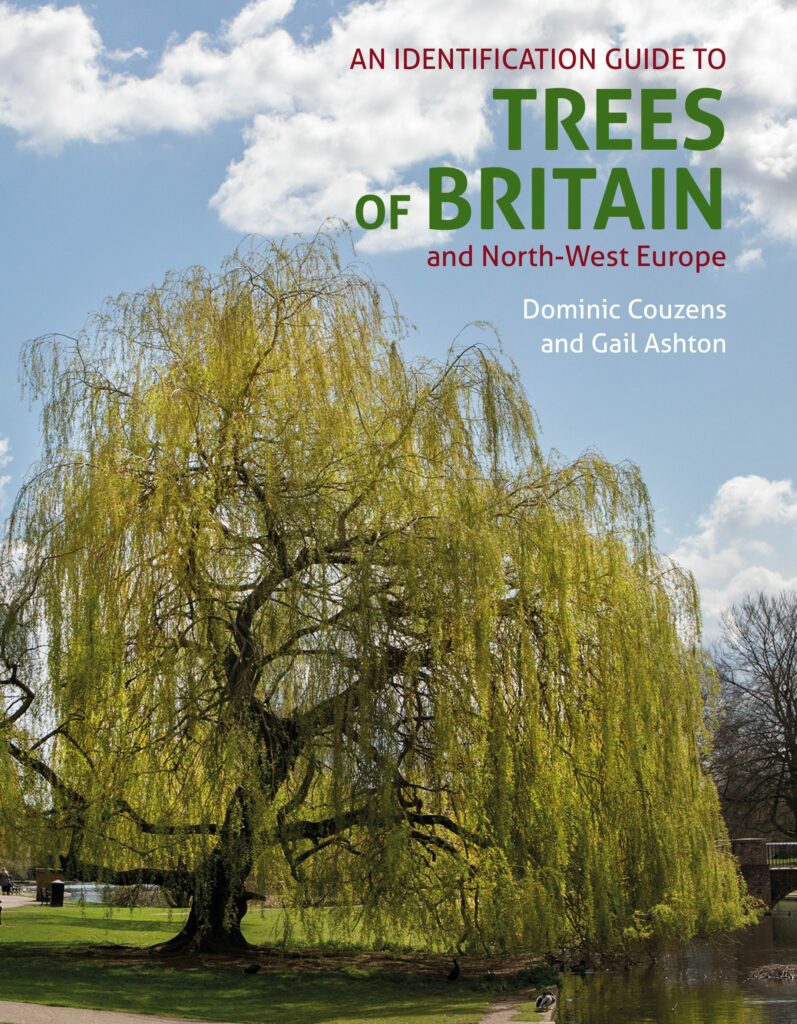 An Identification Guide to Trees of Britain and North-West Europe is a fantastic new guide to 89 of the most commonly found and easily recognised trees in the region. Suitable for everyone, from the complete novice to the experienced naturalist, the book contains lively and interesting text from Dominic Couzens, complemented by Gail Ashton’s photographs. These show details of each species throughout the seasons as well as features that are useful for identification.
An Identification Guide to Trees of Britain and North-West Europe is a fantastic new guide to 89 of the most commonly found and easily recognised trees in the region. Suitable for everyone, from the complete novice to the experienced naturalist, the book contains lively and interesting text from Dominic Couzens, complemented by Gail Ashton’s photographs. These show details of each species throughout the seasons as well as features that are useful for identification.
 Dominic Couzens is a bird expert, nature writer and the author of over 40 books. He is also a regular print columnist and writes for Bird Watching Magazine, Nature’s Home (RSPB) and Water Life (WWT). He is passionate about communicating about the natural world and has a particular passion for writing about current threats to the planet and how they can be best addressed.
Dominic Couzens is a bird expert, nature writer and the author of over 40 books. He is also a regular print columnist and writes for Bird Watching Magazine, Nature’s Home (RSPB) and Water Life (WWT). He is passionate about communicating about the natural world and has a particular passion for writing about current threats to the planet and how they can be best addressed.
 Gail Ashton is a photographer and writer with a passion for wildlife and invertebrates in particular. Well known for an incredible project where she undertook to photograph 500 UK invertebrates over the course of a year, she is passionate about encouraging everyone, young or old, to observe and appreciate the natural world.
Gail Ashton is a photographer and writer with a passion for wildlife and invertebrates in particular. Well known for an incredible project where she undertook to photograph 500 UK invertebrates over the course of a year, she is passionate about encouraging everyone, young or old, to observe and appreciate the natural world.
We recently got to the chance to ask Dominic and Gail some questions about the book; about the process of compiling such a guide, the most fascinating things they learned in the process and their concerns for the future of trees in Britain and further afield.
Firstly, can you tell us a little bit about yourselves and how you came to be working together in writing this book?
DC: I am an experienced writer of natural history books and I’ve written a number of field guides, both to birds and mammals. However, in 2021 I came across Gail’s remarkable project to photograph 500 species of invertebrates in a single year. Her fabulous library was the perfect material for an insect guide, so we published An Identification Guide to Garden Insects in 2022. The project was a great success so here we are.
GA: I have always loved nature and one of my favourite ways to be outdoors is in woodland and forest. Studying insects brought me a new layer of fascination for trees as I found out just how many other organisms they support, and just how complex they are. Trees came on the back of the very-well received ‘Garden Insects’, and follows the same, beautiful format and layout.
There are numerous books available on tree identification. What do you think sets your book apart from other ID guides of its kind?
GA: Yes, there are a good number of outstanding tree guides out there – some of which I use myself. But they can be quite expansive and overwhelming, especially for those of us just starting our tree identification journey. This book is a perfect entry-level guide which introduces you to the different ways in which you can look at trees in order to recognise key features.
DC: It’s very different. For a start, while most tree guides even just to Britain have 300 or more species, we have cut this down to about 90. So it’s simplified and entry-level, including all the common wild species and some introduced ones – those that people might see. It is very far from technical and we have tried to make every species interesting and fun in its own right. We have included some really great facts about many of the trees.
I’m always fascinated by the process behind the compilation of such a comprehensive ID guide. What was the most challenging part of writing this book?
DC: Trees are complicated, with all the different parts from leaves to bark. As the writer of most of the text, even though I had a decent grasp of many British trees, it was always a challenge not to forget all the details. The other very difficult task was in selecting the species. We wanted to include all the species people will notice, including such non-natives as Magnolias and Eucalyptus, while including the bona fide wild trees. But we couldn’t find room for all the tricky willows, and in the end we just hope our choice chimes with people.
GA: Believe it or not, the biggest challenge for me was actually finding the trees. It sounds mad, because trees are everywhere, right? But finding that perfect tree to photograph took a lot of research, walking and finding, and then the light had to be right, so I would revisit trees multiple times. Some of the trees were quite difficult to find, such as the Wild Service and Mulberry, so a lot of detective work was required to pinpoint them. I also had to make repeat visits to capture them in all their seasonal phases. There are trees from all over Europe in this book -thousands of miles and hundreds of hours! But those are the lengths I’ll go to get a great photo.
I particularly enjoyed the fascinating facts that you included for each species in the book. Did you learn anything new or particularly surprising about any of the tree species covered over the course of your research?
DC: I learnt an enormous amount. Did you know that each Holly leaf lives an average of seven years, for example? I also love the fact that Monkey Puzzles are essentially adapted to cope with browsing Sauropod dinosaurs.
GA: I became particularly fascinated with the Ginkgo – a unique throwback to the very beginnings of life on Earth; a tree which is neither conifer nor broadleaf, but somewhere in between.
A big part of conservation and land management is knowing what species are where and how many there are. How much do we currently know about the trees present in Britain and their population sizes?
GA: According to Forestry Research, only 13% of the United Kingdom is currently wooded. That’s such a small percentage compared to a few thousand years ago. Our ancient woodlands have all but disappeared, replaced by farmland, urban development and plantations. Veteran trees are our most important, as they support more communities and sequester more carbon than young trees. It’s essential that our remaining veteran trees and woodland fragments are fully protected to ensure the health of our future natural landscapes.
DC: The recent Atlas of British Flora means that we are well covered in these terms. For some of the rarer trees, such as Black Poplars, we know how many individuals there are of each sex.
Within this guide you include information on the months when leaves, flowers and buds might be seen for each species. Do you have any information or a feel for how rapidly climate change is impacting these features?
DC: Trees are a good early-warnings system, and you don’t need to write a book on trees to see that many are coming out earlier than they used to – hazel catkins in December, for example. However, it was very difficult to get any accurate figures for the book because it varies so much from year to year, and we were also covering Northern Europe as well as Britain. However, we certainly got a feel for the potential problems. Birch catkins are coming out earlier in response to warming, but might be approaching the earliest they can cope with physiologically. Oak budburst will affect both the caterpillars that feed on it and the Blue Tits that feed on the caterpillars. On a wider scale, temperature changes will affect the whole distribution of trees through the country, with northern species retreating. We could lose some specialists such as Dwarf Willow, and the climate will also become easier for introduced trees.
GA: I think that trees are more difficult to use as indicators than insects as trees have a much longer generational turnover, and they don’t move; however monitoring the emergence of blossom and leaves in spring and the falling of leaves in autumn is a great citizen science tool to establish changing trends.
Are there any trees in the UK for which the future seems particularly bleak?
DC: There are well known problems for ash trees and to a lesser extent oaks, and we simply don’t know how far their respective diseases will go. But as a warning, remember that the Field Elm, in its various forms, used to be lowland England’s most abundant tree. Paintings by our forebears of the countryside were often dominated by elms – now they are a shadow of their former selves. And as mentioned above, the warming climate will impact upon our more northerly species.
GA: Ash dieback is currently decimating younger adult trees, though there is a glimmer of hope in that veteran ash are currently immune to the fungus. Juniper is in massive decline across the UK due to loss of suitable habitat.
Finally, what are you both working on now? Do you have plans for further books?
DC: We have co-written two books on insects recently: A Year of Garden Bees and Bugs and An Insect a Day, both of which are published by BT Batsford and are narrative-style books.
GA: I am currently working on upcoming books about invertebrates. I have an exhibition of my photos planned, as well as workshops, talks and podcasts.
An Identification Guide to Trees of Britain and North-West Europe was published by John Beaufoy Publishing in April 2024 and is available from nhbs.com.





